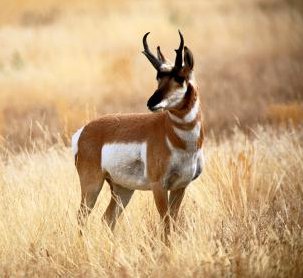Pronghorn Antelope
Category: North American Mammals

Facts about Pronghorn Antelope, "Scientific name for Pronghorn Antelope is Antilocapra americana". Pronghorn Antelope is an Antilocapra variety of animal that comes from the Antilocapridae family. The Pronghorn Antelopes are native to interior central and western parts of North America. Though these deer-like animals are not an antelope, they are often known colloquially in North America, and they are the only existing member of the Antilocapridae family. The Pronghorn Antelope are called by other names, such as the Prong Buck, Cabri, Pronghorn Antelope or just Antelope, as they closely look like the real antelopes of the Old World and have an analogous biological niche attributable to convergent evolution.
Features of Pronghorn Antelope
The Pronghorn Antelope is a deer-like animal, and usually, the male antelopes are bigger and heavier than females. The adult male Pronghorn Antelope has a body length, ranging from 4 1/4 to 4 7/8 (1.3 meters to 1.5 meters), measured from its nose to tail, with a height between 31 7/8 to 40 7/8 inches (81 cm and 104 cm) at the shoulder and their body mass varies from 88.2 to 143.3 pounds (40 kg to 65 kg). Though the female antelopes are equally tall as that of the males, they differ in body mass, weighing between 75 to 105.8 pounds (34 kg and 48 kg). The feet of Pronghorn Antelope have two hooves, without dewclaws.
The eye sockets of the Pronghorn Antelope are prominent and set high on the head, with never an ante-orbital pit. Their teeth of the Pronghorn Antelopes are hypsodont. Each horn of this animal is made of a slim, laterally compressed blade of bone that cultivates from the forward bones of the head, forming a lasting core. In these animals, the skin grows into a keratinous cover that is shed and redevelops on a yearly basis. The horn sheaths of the Pronghorn Antelopes are branched, each cover having a forward-pointing thorn.
Male Pronghorn Antelopes have bigger horns than the females, with a horn sheath length, ranging from 4 7/8 inches to 16 7/8 inches (12.4 cm to 42.9 cm) with a prong, whereas female Pronghorn Antelopes have smaller horns, with the length between 1 inch and 6 inches (2.5 to 15.3 cm) without a prong such that sometimes they are barely visible. Male breeds are further discriminated from females in having a tiny patch of black-colored hair at the angle of their mandible. The Pronghorn Antelopes have a different, musky smell. Male breeds mark territory by means of a pre-orbital odor gland, which is situated on the sides of the skull. The Pronghorn Antelope also boast extremely big eyes with a vision capacity of 320 degrees. With this vision range and very efficient respiratory and circulatory systems, they can perceive predators and flee from them by running at high pace for extended periods. Not like deer, the Pronghorn Antelopes have a gallbladder.
Diet of Pronghorn Antelope
Pronghorn Antelopes are herbivores and they mostly feed on shrubs, forbs, grasses, sagebrush and cacti.
Behavior of Pronghorn Antelope
Pronghorn Antelopes will form mixed-sex groups in the winter. Usually, the groups break up in early spring, with juvenile males forming single groups, females forming their female groups, and mature males living lonely. Some female antelope groups share the similar summer range, and single male groups form between fall and spring. Female Pronghorn Antelope form supremacy hierarchies with a small number of circular relationships. Dominant female breeds will move other female Pronghorn Antelope violently from their feeding locations.
The average lifespan of the Pronghorn Antelope ranges from 10 years to 12 years.

 Back To Category North American Mammals
Back To Category North American Mammals